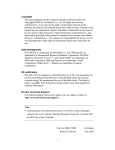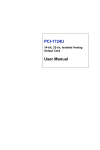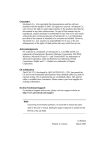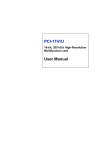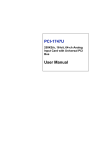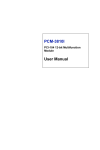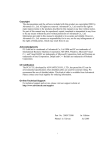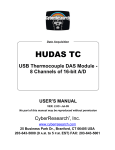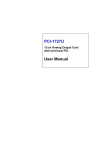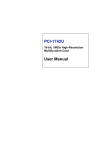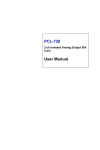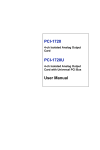Download PCI-1723 User Manual
Transcript
PCI-1723 16-bit, 8-ch., Non-Isolated Analog Output Card User Manual Copyright The documentation and the software included with this product are copyrighted 2006 by Advantech Co., Ltd. All rights are reserved. Advantech Co., Ltd. reserves the right to make improvements in the products described in this manual at any time without notice. No part of this manual may be reproduced, copied, translated or transmitted in any form or by any means without the prior written permission of Advantech Co., Ltd. Information provided in this manual is intended to be accurate and reliable. However, Advantech Co., Ltd. assumes no responsibility for its use, nor for any infringements of the rights of third parties, which may result from its use. Acknowledgements PC-LabCard is a trademark of Advantech Co., Ltd. IBM and PC are trademarks of International Business Machines Corporation. MS-DOS, Windows, Microsoft Visual C++ and Visual BASIC are trademarks of Microsoft Corporation. Intel and Pentium are trademarks of Intel Corporation. Delphi and C++ Builder are trademarks of Inprise Corporation. All other product names or trademarks are properties of their respective owners. Part No. 2003172300 Edition 2 Printed in Taiwan November 2011 PCI-1723 User Manual ii Product Warranty (2 years) Advantech warrants to you, the original purchaser, that each of its products will be free from defects in materials and workmanship for two years from the date of purchase. This warranty does not apply to any products which have been repaired or altered by persons other than repair personnel authorized by Advantech, or which have been subject to misuse, abuse, accident or improper installation. Advantech assumes no liability under the terms of this warranty as a consequence of such events. Because of Advantech’s high quality-control standards and rigorous testing, most of our customers never need to use our repair service. If an Advantech product is defective, it will be repaired or replaced at no charge during the warranty period. For out-of-warranty repairs, you will be billed according to the cost of replacement materials, service time and freight. Please consult your dealer for more details. If you think you have a defective product, follow these steps: 1. Collect all the information about the problem encountered. (For example, CPU speed, Advantech products used, other hardware and software used, etc.) Note anything abnormal and list any on screen messages you get when the problem occurs. 2. Call your dealer and describe the problem. Please have your manual, product, and any helpful information readily available. 3. If your product is diagnosed as defective, obtain an RMA (return merchandize authorization) number from your dealer. This allows us to process your return more quickly. 4. Carefully pack the defective product, a fully-completed Repair and Replacement Order Card and a photocopy proof of purchase date (such as your sales receipt) in a shippable container. A product returned without proof of the purchase date is not eligible for warranty service. 5. Write the RMA number visibly on the outside of the package and ship it prepaid to your dealer. iii CE This product has passed the CE test for environmental specifications when shielded cables are used for external wiring. We recommend the use of shielded cables. This kind of cable is available from Advantech. Please contact your local supplier for ordering information. Technical Support and Assistance Step 1. Visit the Advantech web site at www.advantech.com/support where you can find the latest information about the product. Step 2. Contact your distributor, sales representative, or Advantech's customer service center for technical support if you need additional assistance. Please have the following information ready before you call: - Product name and serial number - Description of your peripheral attachments - Description of your software (operating system, version, application software, etc.) - A complete description of the problem - The exact wording of any error messages Packing List Before setting up the system, check that the items listed below are included and in good condition. If any item does not accord with the table, please contact your dealer immediately. Before you install your PCI-1723 card, please make sure you have the following necessary components: • PCI-1723 DA&C card • PCI-1723 User’s Manual • Advantech DLL drivers (Included in the companion CD-ROM) • Wiring cable PCL-10168 (option) • Wiring board ADAM-3968 (option) • Personal computer or workstation with a PCI-bus slot (running Windows 2000/95/ 98/NT/ME/XP) PCI-1723 User Manual iv Contents Chapter Chapter 1 Introduction ..................................................... 2 1.1 1.2 1.3 Features ............................................................................ 2 Applications ..................................................................... 3 Installation Guide ............................................................. 4 1.4 1.5 1.6 Software Overview........................................................... 6 Device Driver Programming Roadmap ........................... 7 Accessories....................................................................... 9 Figure 1.1:Installation Flow Chart ................................. 5 2 Installation ..................................................... 12 2.1 2.2 Unpacking ...................................................................... 12 Driver Installation .......................................................... 13 2.3 Hardware Installation ..................................................... 15 2.4 Device Setup and Configuration ................................... 17 Figure 2.1:Advantech Automation Software Setup ..... 13 Figure 2.2:Options for Driver Setup ............................ 14 Figure 2.3:Device Name on Device Manager ............. 16 2.4.1 2.4.2 Chapter Setting Up the Device .................................................. 17 Figure 2.4:Device Manager Dialog Box ...................... 17 Figure 2.5:“Device(s) Found” Dialog Box .................. 18 Configuring the Device ................................................ 18 Figure 2.6:Device Setting Dialog Box ......................... 18 Figure 2.7:Device Name on the List of Devices Box .. 19 3 Signal Connections ........................................ 22 3.1 3.2 Overview ........................................................................ 22 Switch and Jumper Settings .......................................... 22 3.2.1 3.2.2 3.2.3 3.2.4 3.3 Signal Connections ........................................................ 25 3.3.1 3.3.2 3.3.3 3.4 Figure 3.1:Card Connector, Jumper & Switches ......... 22 JP9 ................................................................................ 23 JP1~JP8 ........................................................................ 23 Setting the Time to Reset Analog Outputs .................. 23 Board ID setting ........................................................... 24 Pin Assignment ............................................................ 25 Figure 3.2:I/O Connector Pin Assignments ................. 25 I/O Connector Signal Descriptions ................................ 26 Table 3.1:I/O Connector Signal Descriptions .............. 26 Analog Output Connection .......................................... 27 Figure 3.3:Analog Output Connections ....................... 27 Figure 3.4:Current Mode Diagram .............................. 28 Field Wiring Considerations .......................................... 29 Appendix A Specifications ................................................. 32 A.1 A.2 Analog Output .................................................................... 32 Digital Input /Output ...................................................... 32 v Table of Contents A.3 General .......................................................................... 33 Appendix B Block Diagram ............................................... 36 Appendix C Register Structure & Format ....................... 38 C.1 C.2 Overview ........................................................................ 38 I/O Port Address Map ................................................... 38 Table C.1:PCI-1723 Register Format .......................... 39 C.3 D/A ch output data — BASE+00H~0EH ..................... 43 C.4 D/A ch latch data — BASE+00H~0EH......................... 44 C.5 Board ID — BASE+10H ............................................... 45 C.6 All D/A Ch Synchronized Settings — BASE+12H ....... 46 C.7 All D/A Ch Synchronized Status — BASE+12H .......... 46 C.8 DAC Range & Calibration Mode — BASE+14H ......... 47 C.9 DAC Range & Calibration Status — BASE+14H ......... 48 C.10 SADC Control Command for Calibration Function— BASE+16H 49 C.11 SADC Control Status for Calibration Function— BASE+16H 50 C.12 Calibration Parameter Strobe — BASE+18H................ 50 C.13 Digital I/O setting — BASE+1AH ................................ 51 C.14 Digital I/O port mode — BASE+1AH........................... 52 C.15 Write Digital Output Command — BASE+1CH........... 52 C.16 Read Digital Input Data — BASE+1CH ....................... 53 C.17 Write Calibration Command — BASE+1EH ................ 53 C.18 Read calibration status — BASE+1EH.......................... 54 C.19 Synchronized Strobe — BASE+20H ............................. 55 C.20 Reset all D/A channels strobe — BASE+22H ............... 55 C.21 Reset the calibration controller strobe — BASE+24H .. 56 C.22 Change D/A channels output type strobe — BASE+26H .. 56 C.23 Select the calibration Ref_V — BASE+28H ................. 57 C.24 Summary ........................................................................ 57 PCI-1723 User Manual vi CHAPTER 1 2 Introduction This chapter gives background information on the PCI-1723. Sections include: • Features • Applications • Installation Guide • Software Overview • Device Driver Programming Roadmap • Accessories Chapter 1 Introduction Thank you for buying the Advantech PCI-1723. The PCI-1723 is a nonisolated multiple channels analog output card for PCI bus, and each analog output channel is equipped with a 16-bit, double-buffered DAC. It features an auto-calibration function and Board ID. The PCI-1723 is an ideal solution for industrial applications where multiple analog output channels are required. The following sections of this chapter will provide further information about features of the multifunction cards, a Quick Start for installation, together with some brief information on software and accessories for the PCI-1723 card. 1.1 Features • Auto calibration function • A 16-bit DAC is equipped for each of the analog output channels • Flexible output range: ±10 V, 0 ~ 20 mA, 4 ~ 20 mA • Synchronized output function • Output values kept after system hot reset • 2-port (16-channel) user-defined digital input/output • Board ID The Advantech PCI-1723 offers the following main features: Auto-Calibration Function The PCI-1723 provides an auto-calibration function by using a calibration utility. The built-in calibration circuitry of the PCI-1723 corrects gain and offset errors in analog output channels, thereby eliminating the need for external equipment and user adjustments. PCI-1723 User Manual 2 Flexible Voltage Output Range The PCI-1723 provides a fixed voltage output range of °”10 V to fulfill your flexible range needed applications. Users can define the specific voltage output range and output data format via the enclosed software utility and driver. Keeping Output Values After System Reset Users can independently set the eight outputs to different ranges: °”10 V, 0 ~ 20 mA or 4 ~ 20 mA, and all ranges are software selectable. When the system is hot reset (power not shut down), the PCI-1723 can either retain the last analog output values, or return to its default configuration, depending on the jumper setting. This practical function eliminates danger caused by improper operation during unexpected system reset. Board ID The PCI-1723 has a built-in DIP Switch that helps define each card’s ID when multiple PCI-1723 cards have been installed on the same PC chassis. The board ID setting function is very useful when users build their system with multiple PCI-1723 cards. With correct Board ID settings, you can easily identify and access each card during hardware configuration and software programming. Note: For detailed specifications of the PCI-1723, please refer to Appendix A, Specifications. 1.2 Applications • Process control • Programmable voltage source • Programmable current sink • Servo control • Multiple loop PID control 3 Chapter 1 1.3 Installation Guide Before you install your PCI-1723 card, please make sure you have the following necessary components: • PCI-1723 DA&C card • PCI-1723 User’s Manual • Advantech DLL drivers (Included in the companion CD-ROM) • Wiring cable PCL-10168 (option) • Wiring board ADAM-3968 (option) • Personal computer or workstation with a PCI-bus slot (running Windows 2000/95/ 98/NT/ME/XP) Some other optional components are also available for enhanced operation such as application software ActiveDAQ, GeniDAQ and other thirdparty software packages After you get the necessary components and maybe some of the accessories for enhanced operation of your Multifunction card, you can then begin the installation procedure. Figure 1-1 on the next page provides a concise flow chart to give users a broad picture of the software and hardware installation procedures: PCI-1723 User Manual 4 Install Driver from CD -ROM, then power -off PC Install Hardware and power -on PC Use driver utility to configure hardware Use test utility to test hardware Read examples & driver manual Start to wri te your own application Figure 1.1: Installation Flow Chart 5 Chapter 1 1.4 Software Overview Advantech offers a rich set of DLL drivers, third-party driver support and application software to help fully exploit the functions of your PCI-1723 card: • Device Drivers (on the companion CD-ROM) • LabVIEW driver • Advantech ActiveDAQ • Advantech GeniDAQ Programming choices for DA&C cards: You may use Advantech application software such as Advantech Device Drivers. On the other hand, advanced users are allowed another option for register-level programming, although not recommended due to its laborious and time-consuming nature. Device Drivers The Advantech Device Drivers software is included on the companion CD-ROM at no extra charge. It also comes with all the Advantech DA&C cards. Advantech’s Device Drivers features a complete I/O function library to help boost your application performance. The Advantech Device Drivers for Windows 2000/95/98/NT/ME/XP works seamlessly with development tools such as Visual C++, Visual Basic, Inprise C++ Builder and Inprise Delphi. Register-Level Programming Register-level programming is available for experienced programmers who find it necessary to write code directly at the level of the device register. Since register-level programming requires much effort and time, we recommend that you use the Advantech Device Drivers instead. However, if register-level programming is indispensable, you should refer to the relevant information in Appendix C, Register Structure and Format, or to the example codes included on the companion CD-ROM. PCI-1723 User Manual 6 1.5 Device Driver Programming Roadmap This section will provide you a roadmap to demonstrate how to build an application from scratch using Advantech Device Drivers with your favorite development tools such as Visual C++, Visual Basic, Delphi and C++ Builder. The step-by-step instructions on how to build your own applications using each development tool will be given in the Device Drivers Manual. Moreover, a rich set of example source code is also given for your reference. Programming Tools Programmers can develop application programs with their favorite development tools: • Visual C++ • Visual Basic • Delphi • C++ Builder For instructions on how to begin programming works in each development tool, Advantech offers a Tutorial Chapter in the Device Drivers Manual for your reference. Please refer to the corresponding sections in this chapter on the Device Drivers Manual to begin your programming efforts. You can also look at the example source code provided for each programming tool, since they can get you very well oriented. The Device Drivers Manual can be found on the companion CD-ROM. Alternatively, if you have already installed the Device Drivers on your system, The Device Drivers Manual can be readily accessed through the Start button: Start/Programs/Advantech Device Driver V2.0/Device Driver Manual The example source code can be found under the corresponding installation folder such as the default installation path: \Program Files\Advantech\ADSAPI\Examples 7 Chapter 1 For information about using other function groups or other development tools, please refer to the Creating Windows 95/NT/2000 Application with Device Drivers chapter and the Function Overview chapter on the Device Drivers Manual. Programming with Device Drivers Function Library Advantech Device Drivers offer a rich function library that can be utilized in various application programs. This function library consists of numerous APIs that support many development tools, such as Visual C++, Visual Basic, Delphi and C++ Builder. According to their specific functions or services, the APIs can be categorized into several function groups: • Analog Output Function Group • Digital Input/Output Function Group • Counter Function Group • Port Function Group (direct I/O) • Event Function Group For the usage and parameters of each function, please refer to the Function Overview chapter in the Device Drivers Manual. Troubleshooting Device Drivers Error Driver functions will return a status code when they are called to perform a certain task for the application. When a function returns a code that is not zero, it means the function has failed to perform its designated function. To troubleshoot the Device Drivers error, you can pass the error code to DRV_GetErrorMessage function to return the error message. Alternatively, you can refer to the Device Drivers Error Codes Appendix in the Device Drivers Manual for a detailed listing of Error Codes, Error IDs and the Error Messages. PCI-1723 User Manual 8 1.6 Accessories Advantech offers a complete set of accessory products to support the PCI1723 card. These accessories include: Wiring Cable PCL-10168 The PCL-10168 shielded cable is specially designed for PCI-1723 cards to provide high resistance to noise. To achieve a better signal quality, the signal wires are twisted in such a way as to form a “twisted-pair cable,” reducing cross talk and noise from other signal sources. Furthermore, its analog and digital lines are separately sheathed and shielded to neutralize EMI/EMC problems. Wiring Board ADAM-3968 The ADAM-3968 is a 68-pin SCSI wiring terminal module for DIN-rail mounting. This terminal module can be readily connected to the Advantech PC-Lab cards and allow easy yet reliable access to individual pin connections for the PCI-1723 card. 9 Chapter 1 PCI-1723 User Manual 10 CHAPTER 2 2 Installation This chapter gives users a package item checklist, proper instructions for unpacking and step-by-step procedures for both driver and card installation. Sections include: • Unpacking • Driver Installation • Hardware Installation • Device Setup and Configuration Chapter 2 Installation 2.1 Unpacking After receiving your PCI-1723 package, please inspect its contents first. The package should contain the following items: • PCI-1723 card • Companion CD-ROM (Device Drivers included) • User Manual The PCI-1723 card harbors certain electronic components vulnerable to electrostatic discharge (ESD). ESD can easily damage the integrated circuits and certain components if preventive measures are ignored. Before removing the card from the antistatic plastic bag, you should take the following precautions to ward off possible ESD damage: • Touch the metal part of your computer chassis with your hand to discharge the static electricity accumulated on your body. Alternatively, one can also use a grounding strap. • Touch the anti-static bag to a metal part of your computer chassis before opening the bag. • Take hold of the card only by the metal bracket when removing it out of the bag. After taking out the card, you should first: • Inspect the card for any possible signs of external damage (loose or damaged components, etc.). If the card is visibly damaged, please notify our service department or our local sales representative immediately. Do not install a damaged card into your system. Also, pay extra caution to the following aspects to ensure proper installation: • Avoid physical contact with materials that could hold static electricity such as plastic, vinyl and Styrofoam. PCI-1723 User Manual 12 • Whenever you handle the card, grasp it only by its edges. DO NOT TOUCH the exposed metal pins of the connector or the electronic components. Note: Keep the anti-static bag for future use. You might need the original bag to store the card if you have to remove the card from PC or transport it elsewhere. 2.2 Driver Installation We recommend you to install the driver before you install the PCI-1723 card into your system, since this will guarantee a smooth installation process. The Advantech Device Drivers Setup program for the PCI-1723 card is included in the companion CD-ROM that is shipped with your DA&C card package. Please follow the steps below to install the driver software: Step 1: Insert the companion CD-ROM into your CD-ROM drive. Step 2: The Setup program will be launched automatically if you have the autoplay function enabled on your system. When the Setup Program is launched, you will see the following Setup Screen. Figure 2.1: Advantech Automation Software Setup 13 Chapter 2 Note: If the autoplay function is not enabled on your computer, use Windows Explorer or Windows Run command to execute SETUP.EXE on the companion CDROM. Step 3: Select the Device Drivers option. Step 4: Select the specific device then just follow the installation instructions step by step to complete your device driver installation and setup. Figure 2.2: Options for Driver Setup For further information on driver-related issues, an online version of the Device Drivers Manual is available by accessing the following path: Start/Programs/Advantech Device Drivers V2.0/Device Drivers Manual PCI-1723 User Manual 14 2.3 Hardware Installation Make sure you have installed the driver first before you install the card (please refer to 2.2 Driver Installation). After the Device Drivers installation is completed, you can then install the PCI-1723 card into any PCI slot on your computer. However, it is suggested that you refer to the computer user’s manual or related documentation if you have any doubt. Please follow the steps below to install the card onto your system. 1. Turn off your computer and unplug the power cord and cables. TURN OFF your computer before installing or removing any components on the computer. 2. Remove the cover of your computer. 3. Remove the slot cover on the back panel of your computer. 4. Touch the metal part on the surface of your computer to neutralize the static electricity that might be on your body. 5. Insert the PCI-1723 card into a PCI slot. Hold the card only by its edges and carefully align it with the slot. Insert the card firmly into place. Use of excessive force must be avoided; otherwise, the card might be damaged. 6. Fasten the bracket of the PCI card on the back panel rail of the computer with screws. 7. Connect appropriate accessories (68-pin cable, wiring terminals, etc. if necessary) to the PCI card. 8. Replace the cover of your computer chassis. Re-connect the cables you removed in step 2. 9. Plug in the power cord and turn on the computer. Note: In case you installed the card without installing the Device Drivers first, Windows 95/98/ME will recognize your card as an “unknown device” after rebooting, and will prompt you to provide the necessary driver. You should ignore the prompting messages (just click the Cancel button) and set up the driver according to the steps described in 2.2 Driver Installation. 15 Chapter 2 After the PCI-1723 card is installed, you can verify whether it is properly installed on your system in the Device Manager: 1. Access the Device Manager through Control Panel/System/Device Manager. 2. The device name of the PCI-1723 should be listed on the Device Manager tab on the System Property Page. Figure 2.3: Device Name on Device Manager If your card is properly installed, you should see the device name of your card listed on the Device Manager tab. If you do see your device name listed on it but marked with an exclamation sign “!”, it means your card has not been correctly installed. In this case, remove the card device from the Device Manager by selecting its device name and press the Remove button. Then go through the driver installation process again. After your card is properly installed on your system, you can now configure your device using the Advantech Device Manager Program that has itself already been installed on your system during driver setup. A complete device installation procedure should include device setup, configuration and testing. The following sections will guide you through the Setup, Configuration and Testing of your device. PCI-1723 User Manual 16 2.4 Device Setup and Configuration The Advantech Device Manager program is a utility that allows you to set up, configure and test your device, and later stores your settings on the system registry. These settings will be used when you call the APIs of Advantech Device Drivers. 2.4.1 Setting Up the Device 1. To install the I/O device for your card, you must first run the Device Installation program (by accessing Start/Programs/ Advantech Device Driver V2.0). 2. You can then view the device(s) already installed on your system (if any) on the Installed Devices list box. Since you have not installed any device yet, you might see a blank list such as the one below (Fig. 2-4). Figure 2.4: Device Manager Dialog Box 17 Chapter 2 3. Scroll down the List of Devices box to find the device that you wish to install, then click the Add… button to evoke the Device(s) found dialog box such as one shown in Fig. 2-5. The Device(s) found dialog box lists all the installed devices on your system. Select the device you want to configure from the list box and press the OK button. After you have clicked OK, you will see a Device Setting dialog box such as the one in Fig. 2-6. Figure 2.5: “Device(s) Found” Dialog Box 2.4.2 Configuring the Device 4. On the Device Setting dialog box (Fig. 2-6), you can configure the voltage output range for the 8 D/A channels. Figure 2.6: Device Setting Dialog Box PCI-1723 User Manual 18 When selected as External, the external reference voltage determines the output voltage range in the following way: By inputting an external reference voltage: -xV, where |x| <= 10, you will get a output voltage range: 0 to xV. 5. After you have finished configuring the device, click OK and the device name will appear in the Installed Devices box as seen below: Figure 2.7: Device Name on the List of Devices Box Note: As we have noted, the device name “000:PCI-1723 BoardID=0 I/O=6500H” begins with a device number “000”, which is specifically assigned to each card. The device number is passed to the driver to specify which device you wish to control. 19 Chapter 2 After your card is properly installed and configured, you can click the Test… button to test your hardware by using the testing utility supplied. For more detailed information, please refer to Chapter 2 of the Device Drivers Manual. You can also find examples on the CD-ROM to speed up your programming. PCI-1723 User Manual 20 CHAPTER 3 2 Signal Connections This chapter gives an overview of the signal connections of PCI-1723. Sections include: • Overview • Switch and Jumper Settings • Signal Connections • Field Wiring Considerations Chapter 3 Signal Connections 3.1 Overview Maintaining signal connections is one of the most important factors in ensuring that your application system is sending and receiving data correctly. A good signal connection can avoid unnecessary and costly damage to your PC and other hardware devices. This chapter provides useful information about how to connect input and output signals to the PCI1723 via the I/O connector. 3.2 Switch and Jumper Settings The PCI-1723 card has one function switch and five jumper settings. Figure 3.1: Card Connector, Jumper & Switches PCI-1723 User Manual 22 3.2.1 JP9 Keep last status after hot reset. Default configuration. 3.2.2 JP1~JP8 4~20 mA 0~20 mA 3.2.3 Setting the Time to Reset Analog Outputs Some users will want the capability of clearing each analog output when the system (or PC) issues a reset signal on the PCI bus. Some users will want to clear their analog output only as part of system power-on. The PCI-1723 satisfies both these needs by providing jumper JP1. Depending on the application, this capability may allow analog outputs to be "ZERO" without requiring a complete shutdown of processes controlled by the card. Complete loss of power to the chip clears the chip memory. Thus, no matter how JP1 is set, if the power to the PCI-1723 is disconnected, the analog output initial power-on state will be "ZERO". 23 Chapter 3 3.2.4 Board ID setting ID3 ID2 ID1 ID0 Board ID 1 1 1 1 0 1 1 1 0 1 1 1 0 1 2 1 1 0 0 3 1 0 1 1 4 1 0 1 0 5 1 0 0 1 6 1 0 0 0 7 0 1 1 1 8 0 1 1 0 9 0 1 0 1 10 0 1 0 0 11 0 0 1 1 12 0 0 1 0 13 0 0 0 1 14 0 0 0 0 15 Note: On: 1, Off: 0 PCI-1723 User Manual 24 3.3 Signal Connections 3.3.1 Pin Assignment Figure 3-2 shows the pin assignments for the 68-pin I/O connector on the PCI-1723. Figure 3.2: I/O Connector Pin Assignments 25 Chapter 3 3.3.2 I/O Connector Signal Descriptions Table 3.1: I/O Connector Signal Descriptions Signal Name Reference Direction Description Vout<0..3> AGND Output Voltage Output, Channels 0 through 3. Iout<0..3> AGND Output Current Output, Channels 0 through 3. AGND - - Analog Ground. The two ground references (AGND and DGND) are connected together on the PCI-1723 card. DI0<0..15> DGND - Digital Input / Output signals. These pins are digital input / Output channel 0 to 15. DGND - - Digital Ground. The two ground references (AGND and DGND) are connected together on the PCI-1723 card. +12V DGND Output +12 VDC Source (from PCI bus directly with FUSE protection). +5V DGND Output +5 VDC Source (from PCI bus directly with FUSE protection). PCI-1723 User Manual 26 3.3.3 Analog Output Connection The PCI-1723 provides eight D/A output channels, Vout_0 ~ Vout_7 and Iout_0 ~ Iout_7. Voltage Mode: Figure 3-3 shows how to make analog output and external reference input connections on the PCI-1723. Figure 3.3: Voltage Mode Connections 27 Chapter 3 Current Mode (Sink type): Caution: The external voltage should be under 30 V Ri: Internal resistor = 249 ohm Vext: External voltage Isink: The controlled current output (0~20 mA) Since Isink = Vext / (Ri+RL), RL cannot be higher than | Vext/Imax | - Ri For Example: Vext = 24 V, Imax = 20 mA RL max = | 24 V / 20 mA | - 249 = 951 (ohm) Figure 3.4: Current Mode Connection PCI-1723 User Manual 28 3.4 Field Wiring Considerations When you use the PCI-1723 to acquire data from outside, noises in the environment might significantly affect the accuracy of your measurements if due cautions are not taken. The following measures will be helpful to reduce possible interference running signal wires between signal sources and the PCI-1723. The signal cables must be kept away from strong electromagnetic sources such as power lines, large electric motors, circuit breakers or welding machines, since they may cause strong electromagnetic interference. Keep the analog signal cables away from any video monitor, since it can significantly affect a data acquisition system. If the cable travels through an area with significant electromagnetic interference, you should adopt individually shielded, twisted-pair wires as the analog input cable. This type of cable has its signal wires twisted together and shielded with a metal mesh. The metal mesh should only be connected to one point at the signal source ground. Avoid running the signal cables through any conduit that might have power lines in it. If you have to place your signal cable parallel to a power line that has a high voltage or high current running through it, try to keep a safe distance between them. Alternatively, you can place the signal cable at a right angle to the power line to minimize the undesirable effect. The signals transmitted on the cable will be directly affected by the quality of the cable. In order to ensure better signal quality, we recommend that you use the PCL-10168 shielded cable. 29 Chapter 3 PCI-1723 User Manual 30 APPENDIX A 2 Specifications This appendix provides information on the specifications of PCI-1723. Sections include: • Analog Output • Digital Input/Output • General Appendix A Specifications A.1 Analog Output Channels 8 Resolution 16-bit Operation mode Single output, Synchronized output Output Range (Internal Reference only) -10 ~+10 V, 0 ~ 20 mA, 4 ~ 20 mA Driving Capability 5 mA Accuracy Relative ±6 LSB Differential Non-linearity ±6 LSB (monotonic) Offset < 6 LSB Output Impedance 0.1 max. Throughput PC dependent, Software update (direct AO) Settling time 50 us (to °”6 LSB of FSR) A.2 Digital Input /Output Input Channels 16 (bi-directional) Number of ports 2 Input Voltage Low 0.8 V max. High 2.0 V min. Low 0.5 V max. @ +24 mA (sink) High 2.0 V min. @ -15 mA (source) Output Voltage PCI-1723 User Manual 32 A.3 General I/O Connector Type 68-pin SCSI-II female Dimensions 175 x 100 mm (6.9" x 3.9") Power Consumption Typical +5 V @ 850 mA, +12 V @ 600 mA Max. +5 V @ 1 A, +12 V @ 700 mA Temperature Operation 0 ~ 60°C (32 ~158°F) (refer to IEC 68-2-1,2) Storage -20~85°C (-4~185°F) Relative Humidity 5~95% RH non-condensing (refer to IEC 68-2-3) Certifications CE certified 33 Appendix A PCI-1723 User Manual 34 APPENDIX B 2 Block Diagram This appendix shows the block diagram for PCI-1723. Appendix B Block Diagram Bidirectional And Latched 8 Bits DIO DIO[7:0] Bidirectional And Latched 8 Bits DIO DIO[15:8] Iout 0 16-Bit DAC 0 Vout 0 Iout 1 16-Bit DAC 1 PCI Interface Vout 1 Iout 2 16-Bit DAC 2 Vout 2 Local Bus PCI Bus Iout 3 16-Bit DAC 3 Vout 3 Iout 4 16-Bit DAC 4 Vout 4 Iout 5 16-Bit DAC 5 Vout 5 Iout 6 16-Bit DAC 6 Vout 6 Iout 7 16-Bit DAC 7 Vout 7 Auto Calibration Circuit PCI-1723 User Manual 36 APPENDIX C 2 Register Structure & Format This chapter provides information on the system settings of UNO-2052. Sections include: • Board Connectors and Jumpers • RS-232 Standard Serial Port • CAN Serial Port • Ethernet RJ-45 Connector • Phoenix Power Connector (PWR) • PS/2 Keyboard and Mouse Connector • USB Connector • VGA Display Connector • CompactFlash Master/Slave Jumper Setting Appendix C Register Structure & Format C.1 Overview The PCI-1723 is delivered with an easy-to-use 32-bit Device Drivers for user programming under the Windows 2000/95/98/NT/ME/XP operating system. We advise users to program the PCI-1723 using the 32-bit Device Drivers provided by Advantech to avoid the complexity of low-level registry programming. The most important consideration in programming the PCI-1723 the register level is to understand the function of the card's registers. The information in the following sections is provided only for users who would like to do their own low-level programming. C.2 I/O Port Address Map The PCI-1723 requires 32 consecutive addresses in the PC's I/O space. The address of each register is specified as an offset from the card's base address. For example, BASE+0 is the card's base address and BASE+7 is the base address plus seven bytes. Table C-1 shows the function of each register of the PCI-1723 or driver and its address relative to the card's base address. PCI-1723 User Manual 38 Table C.1: PCI-1723 Register Format Base Adr. +HEX 00 H PCI-1723 Register Format 15 14 13 12 11 10 9 8 7 6 5 4 3 2 1 0 DA 11 DA 10 DA 9 DA 8 DA 7 DA 6 DA 5 DA 4 DA 3 DA 2 DA 1 DA 0 DA 11 DA 10 DA 9 DA 8 DA 7 DA 6 DA 5 DA 4 DA 3 DA 2 DA 1 DA 0 DA 11 DA 10 DA 9 DA 8 DA 7 DA 6 DA 5 DA 4 DA 3 DA 2 DA 1 DA 0 DA 11 DA 10 DA 9 DA 8 DA 7 DA 6 DA 5 DA 4 DA 3 DA 2 DA 1 DA 0 DA 11 DA 10 DA 9 DA 8 DA 7 DA 6 DA 5 DA 4 DA 3 DA 2 DA 1 DA 0 DA 11 DA 10 DA 9 DA 8 DA 7 DA 6 DA 5 DA 4 DA 3 DA 2 DA 1 DA 0 DA 11 DA 10 DA 9 DA 8 DA 7 DA 6 DA 5 DA 4 DA 3 DA 2 DA 1 DA 0 DA 11 DA 10 DA 9 DA 8 DA 7 DA 6 DA 5 DA 4 DA 3 DA 2 DA 1 DA 0 DA 11 DA 10 DA 9 DA 8 DA 7 DA 6 DA 5 DA 4 DA 3 DA 2 DA 1 DA 0 DA 11 DA 10 DA 9 DA 8 DA 7 DA 6 DA 5 DA 4 DA 3 DA 2 DA 1 DA 0 DA 11 DA 10 DA 9 DA 8 DA 7 DA 6 DA 5 DA 4 DA 3 DA 2 DA 1 DA 0 DA 11 DA 10 DA 9 DA 8 DA 7 DA 6 DA 5 DA 4 DA 3 DA 2 DA 1 DA 0 W D/A channel 0 output data DA 15 DA 14 DA 13 DA 12 R D/A channel 0 latch data DA 15 02 H DA 14 DA 13 DA 12 W D/A channel 1 output data DA 15 DA 14 DA 13 DA 12 R D/A channel 1 latch data DA 15 04 H DA 14 DA 13 DA 12 W D/A channel 2 output data DA 15 DA 14 DA 13 DA 12 R D/A channel 2 latch data DA 15 06 H DA 14 DA 13 DA 12 W D/A channel 3 output data DA 15 DA 14 DA 13 DA 12 R D/A channel 3 latch data DA 15 08 H DA 14 DA 13 DA 12 W D/A channel 4 output data DA 15 DA 14 DA 13 DA 12 R D/A channel 4 latch data DA 15 0A H DA 14 DA 13 DA 12 W D/A channel 5 output data DA 15 DA 14 DA 13 DA 12 R D/A channel 5 latch data DA 15 DA 14 DA 13 DA 12 39 Appendix C Table C.1: PCI-1723 Register Format 0C H W D/A channel 6 output data DA 15 DA 14 DA 13 DA 12 DA 11 DA 10 DA 9 DA 8 DA 7 DA 6 DA 5 DA 4 DA 3 DA 2 DA 1 DA 0 DA 11 DA 10 DA 9 DA 8 DA 7 DA 6 DA 5 DA 4 DA 3 DA 2 DA 1 DA 0 DA 11 DA 10 DA 9 DA 8 DA 7 DA 6 DA 5 DA 4 DA 3 DA 2 DA 1 DA 0 R D/A channel 6 latch data DA 15 0E H DA 14 DA 13 DA 12 W D/A channel 7 output data DA 15 DA 14 DA 13 DA 12 R D/A channel 7 latch data DA 15 10 H DA 14 DA 13 DA 12 DA 11 DA 10 DA 9 DA 8 DA 7 DA 6 DA 5 DA 4 DA 3 DA 2 DA 1 DA 0 0 0 0 0 0 0 0 0 0 0 B D3 BD 2 BD 1 B D0 X X X X X X X X X SY N C 0 0 0 0 0 0 0 0 0 SY N C X SE LF X X R1 R0 O _ G C H2 CH 1 C H0 X SE LF ID X1 ID X0 R1 R0 O _ G C H2 CH 1 C H0 X X X X X X CS DA T CL K X X X X X X CS DA T CL K W N/A R Board ID 0 12 H 0 W All D/A channels synchronized setting X X X X X X R All D/A channels synchronized status 0 14 H 0 0 0 0 0 W DAC range and calibration mode X X X X X X R DAC range and calibration status BU SY 16 H INI T X X X X W SADC control command for calibration function X X X X X X X R SADC control status for calibration function X X X PCI-1723 User Manual X X X X 40 18 H W Calibration parameter strobe X X X X X X X X X X X X X X X X X X X X X X X X X X HD IO LD IO 0 0 0 0 0 0 0 0 0 0 HD IO LD IO D1 1 D1 0 D9 D8 D7 D6 D5 D4 D3 D2 D1 D0 D1 1 D1 0 D9 D8 D7 D6 D5 D4 D3 D2 D1 D0 X X X X D7 D6 D5 D4 D3 D2 D1 D0 0 0 0 0 D7 D6 D5 D4 D3 D2 D1 D0 R N/A 1A H W Digital I/O port setting X X X X R Digital I/O port mode 0 1C H 0 0 0 W Write digital output command D1 5 D1 4 D1 3 D1 2 R Read digital input data D1 5 1E H D1 4 D1 3 D1 2 W Write calibration command X X X X R Read calibration status 0 0 0 0 41 Appendix C Table C-1 PCI-1723 register format (Part 3) Base Address + HEX 20 W H 22 H 24 H 26 H 28 H PCI-1723 Register Format 15 14 13 12 11 10 9 8 7 6 4 3 2 1 0 X X X X X X X X X X X X X X X X X X X X X X X X X X X X X X X X X X X X X X X X X X RE R F_ E A1 F _ A 0 R N/A W Reset all D/A channels strobe X X X X X X X X X X X X R N/A W Reset the calibration controller strobe X X X X X X X X X X X X R N/A W Change D/A channels output type strobe X X X X X X R N/A W Select the calibration Ref_V X R 5 Synchronized strobe X X X X X N/A PCI-1723 User Manual 42 C.3 D/A ch output data — BASE+00H~0EH Table C-2 Register for D/A Channels Output Data Base Addr. 00 W H 15 14 13 12 11 10 9 8 7 6 5 4 3 2 1 0 D/A channel 0 output data 02 H W DA D DA D DA DA D D DA DA DA DA DA DA DA DA0 15 A1 13 A1 11 10 A A8 7 6 5 4 3 2 1 4 2 9 D/A channel 1 output data 04 H W DA D DA D DA DA D D DA DA DA DA DA DA DA DA0 15 A1 13 A1 11 10 A A8 7 6 5 4 3 2 1 4 2 9 D/A channel 2 output data 06 H W DA D DA D DA DA D D DA DA DA DA DA DA DA DA0 3 2 1 15 A1 13 A1 11 10 A A8 7 6 5 4 4 2 9 D/A channel 3 output data 08 H W DA D DA D DA DA D D DA DA DA DA DA DA DA DA0 15 A1 13 A1 11 10 A A8 7 6 5 4 3 2 1 4 2 9 D/A channel 4 output data 0A W H 0C W H 0E W H DA D DA D DA DA D D DA DA DA DA DA DA DA DA0 15 A1 13 A1 11 10 A A8 7 6 5 4 3 2 1 4 2 9 D/A Channel 5 output data DA D DA D DA DA D D DA DA DA DA DA DA DA DA0 6 5 4 3 2 1 15 A1 13 A1 11 10 A A8 7 4 2 9 D/A channel 6 output data DA D DA D DA DA D D DA DA DA DA DA DA DA DA0 15 A1 13 A1 11 10 A A8 7 6 5 4 3 2 1 4 2 9 D/A channel 7 output data DA D DA D DA DA D D DA DA DA DA DA DA DA DA0 15 A1 13 A1 11 10 A A8 7 6 5 4 3 2 1 4 2 9 DA15 ~ DA0 D/A channel output data DA0 the least significant bit (LSB) of the D/A data DA15 the most significant bit (MSB) 43 Appendix C C.4 D/A ch latch data — BASE+00H~0EH Table C-3 Register for D/A Channels Latch Data Base Addr. 00 R H 15 14 13 12 11 10 9 8 7 6 5 4 3 2 1 0 D/A channel 0 latch data 02 H R DA DA DA DA DA DA DA DA DA DA DA DA DA DA D D 15 14 13 12 11 10 9 8 7 6 5 4 3 2 A A 1 0 D/A channel 1 latch data 04 H R DA DA DA DA DA DA DA DA DA DA DA DA DA DA D D 15 14 13 12 11 10 9 8 7 6 5 4 3 2 A A 1 0 D/A channel 2 latch data 06 H R DA DA DA DA DA DA DA DA DA DA DA DA DA DA D D 15 14 13 12 11 10 9 8 7 6 5 4 3 2 A A 1 0 D/A channel 3 latch data 08 H R DA DA DA DA DA DA DA DA DA DA DA DA DA DA D D 15 14 13 12 11 10 9 8 7 6 5 4 3 2 A A 1 0 D/A channel 4 latch data 0A R H 0C R H 0E R H DA DA DA DA DA DA DA DA DA DA DA DA DA DA D D 15 14 13 12 11 10 9 8 7 6 5 4 3 2 A A 1 0 D/A channel 5 latch data DA DA DA DA DA DA DA DA DA DA DA DA DA DA D D 15 14 13 12 11 10 9 8 7 6 5 4 3 2 A A 1 0 D/A channel 6 latch data DA DA DA DA DA DA DA DA DA DA DA DA DA DA D D 15 14 13 12 11 10 9 8 7 6 5 4 3 2 A A 1 0 D/A channel 7 latch data DA DA DA DA DA DA DA DA DA DA DA DA DA DA D D 15 14 13 12 11 10 9 8 7 6 5 4 3 2 A A 1 0 DA15 ~ DA0 D/A channel latch data DA0 the least significant bit (LSB) of the D/A data DA15 the most significant bit (MSB) PCI-1723 User Manual 44 C.5 Board ID — BASE+10H The PCI-1723 offers Board ID register BASE+10H. With correct Board ID settings, users can easily identify and access each card during hardware configuration and software programming. Table C-4 Register for Board ID Base Addr. 10 R H 15 14 13 12 11 10 9 8 7 6 5 4 3 2 1 0 0 0 0 0 0 0 BD BD BD BD 3 2 1 0 Board ID 0 0 0 0 0 0 BD3 ~ DB0 Board ID BD0 LSB of the Board ID BD3 MSB of the Board ID BD3 1 1 1 1 1 1 1 1 0 0 0 0 0 0 0 0 BD2 1 1 1 1 0 0 0 0 1 1 1 1 0 0 0 0 BD1 1 1 0 0 1 1 0 0 1 1 0 0 1 1 0 0 45 BD0 1 0 1 0 1 0 1 0 1 0 1 0 1 0 1 0 Board ID 15 14 13 12 11 10 9 8 7 6 5 4 3 2 1 0 Appendix C C.6 All D/A Ch Synchronized Settings — BASE+12H The PCI-1723 provides an innovate function in which all D/A channels can output their data in synchronization. Table C-5 Register for all D/A channels synchronized setting Base Addr. 12 W H 15 14 13 12 11 10 9 8 7 6 5 4 3 2 1 0 X X X X X X SY NC All D/A channels synchronized setting X X X X X X X X X SYNC D/A channels output synchronous 0 Disable (all D/A channels output directly) 1 Enable Note: Be sure to enable the synchronize function by writing the value to this register first. Next, write the specific data into BASE+00H ~ 0FH. Lastly, write any value to BASE+12H to synchronize all D/A channels. On the other hand, it you did not enable the synchronize function by writing the value to this register first, all the specific data which was written to BASE+00H ~ 0FH will be output immediately! C.7 All D/A Ch Synchronized Status — BASE+12H Table C-6 Register for All D/A Channels Synchronized Status Base Addr. 12 R H 15 14 13 12 11 10 9 8 7 6 5 4 3 2 1 0 0 0 0 0 0 0 SY NC All D/A channels synchronized status 0 0 0 0 0 0 0 0 0 SYNC D/A channels output synchronous 0 Disable (all D/A channels output directly) 1 Enable PCI-1723 User Manual 46 C.8 DAC Range & Calibration Mode — BASE+14H Table C-7 Register for DAC Range and Calibration Mode Base Addr. 14 W H 15 14 13 12 11 10 9 8 7 6 5 4 3 2 1 0 SE X LF X R1 R0 O_ CH CH CH G 2 1 0 DAC range and calibration mode X X X X X X X CH2 ~ CH0 Select D/A channel 000 Channel 0 001 Channel 1 010 Channel 2 011 Channel 3 100 Channel 4 101 Channel 5 110 Channel 6 111 Channel 7 O_G Calibrate gain or offset 0 Gain 1 Offset R1 ~ R0 Select D/A range 00 ± 10V 01 N/A 10 0 ~ 20 mA 11 4 ~ 20 mA SELF Select normal or self-system calibration 0 Normal calibration 1 Self-system offset calibration 47 Appendix C Note: Once you want to change the range of the specific channel, be sure to write the value to this register first. After that, write any value to BASE+26H to strobe the change. C.9 DAC Range & Calibration Status — BASE+14H Table C-8 Register for DAC range and calibration status Base Addr. 14 R H 15 14 13 12 11 10 9 8 7 6 5 4 3 2 1 0 DAC range and calibration status BU INI X SY T X X X X SE ID ID R1 R0 O_ CH CH CH LF X1 X0 G 2 1 0 CH2 ~ CH0 Select D/A channel 000 Channel 0 001 Channel 1 010 Channel 2 011 Channel 3 100 Channel 4 101 Channel 5 110 Channel 6 111 Channel 7 O_G Calibrate gain or offset 0 Gain 1 Offset R1 ~ R0 Select D/A range 00 ± 10V 01 N/A PCI-1723 User Manual 48 10 0 ~ 20 mA 11 4 ~ 20 mA SELF Select normal or self-system calibration 0 Normal calibration 1 Self-system offset calibration INIT Initial the calibration controller 0 Idle 1 Processing BUSY Calibration controller busy flag 0 Idle 1 Busy IDX1 ~ IDX0 Calibration procedure index 00 Read/Write calibration status 01 Write calibration parameter 10 Change D/A channels output type and reload the parameters 11 N/A C.10 SADC Control Command for Calibration Function— BASE+16H The PCI-1723 uses SADC (serial analog to digital converter) for the calibration function. Please refer to the Burr-Brown ADS7822 data sheet for the chipset detailed information (CD-ROM:\Documents\Component Specification\ ADS7822.PDF). Table C-9 Register for SADC control command for calibration function Base Addr. 16 W H CS 15 14 13 12 11 10 9 8 7 6 5 4 3 2 1 0 X X CS DA CL T K SADC control command for calibration function X X X X X X X X X X X SADC chip select (active low) 49 Appendix C DAT SADC serial data CLK SADC clock C.11 SADC Control Status for Calibration Function— BASE+16H Table C-10 Register for SADC control for calibration function Base Addr. 16 R H 15 14 13 12 11 10 9 8 7 6 5 4 3 2 1 0 X X X CS DA CL T K SADC control status for calibration function X X X X X X X X X X CS SADC chip select (active low) DAT SADC serial data CLK SADC clock C.12 Calibration Parameter Strobe — BASE+18H Write any values to BASE+18H after finishing the calibration procedure to save all the D/A channels’ parameters into the EEPROM. Table C-11 Register for calibration parameter strobe Base Addr. 18 W H 15 14 13 12 11 10 9 8 7 6 5 4 3 2 1 0 X X X X X X X X X Calibration parameter strobe X X X PCI-1723 User Manual X X X X 50 Note: If you want to calibrate the range of the specific channel, be sure to write the value to BASE+14H first. Next, write the data to BASE+1EH for calibration purposes. Lastly, write the value to this register to strobe the parameters into EEPROM. C.13 Digital I/O setting — BASE+1AH Table C-12 Register for digital I/O port setting Base Addr. 1A W H 15 14 13 12 11 10 9 8 7 6 5 4 3 2 1 0 X X X X X X X X HD LDI IO O Digital I/O port setting X X X X X X LDIO Setting the Low byte DIO port 0 Output 1 Input HDIO Setting the High byte DIO port 0 Output 1 Input Note: The port that is setup as output supports ‘read back’ function. The port that setup as input supports ‘mask’ function. Above registries must be accessed by one word at a time. 51 Appendix C C.14 Digital I/O port mode — BASE+1AH Table C-13 Register for digital I/O port modes Base Addr. 1A R H 15 14 13 12 11 10 9 8 7 6 5 4 3 2 1 0 0 0 0 0 0 0 0 HD LDI IO O Digital I/O port mode 0 0 0 0 0 0 0 LDIO Status of the Low byte DIO port 0 Output 1 Input HDIO Status of the High byte DIO port 0 Output 1 Input C.15 Write Digital Output Command — BASE+1CH Table C-14 Register for write digital output command Base Addr. 1C W H 15 14 13 12 11 10 9 8 7 6 5 4 3 2 1 0 Write digital output command D1 D1 D1 D1 D1 D1 D9 D8 D7 D6 D5 D4 D3 D2 D1 D0 5 4 3 2 1 0 D15 ~ D0 Digital output data D0 LSB of the output data D15 MSB of the output data PCI-1723 User Manual 52 C.16 Read Digital Input Data — BASE+1CH Table C-15 Register for Read Digital Input Data Base Addr. 1C R H 15 14 13 12 11 10 9 8 7 6 5 4 3 2 1 0 Read digital input data D1 D1 D1 D1 D1 D1 D9 D8 D7 D6 D5 D4 D3 D2 D1 D0 5 4 3 2 1 0 D15 ~ D0 Digital input data D0 LSB of the input data D15 MSB of the input data C.17 Write Calibration Command — BASE+1EH Table C-16 Register for write calibration command Base Addr. 1E W H 15 14 13 12 11 10 9 8 7 6 5 4 3 2 1 0 X D7 D6 D5 D4 D3 D2 D1 D0 Write calibration command X X X X X X X D7 ~ D0 Calibration result data D0 the least significant bit (LSB) of the data D7 the most significant bit (MSB) Note: If you want to calibrate the range of the specific channel, be sure to write the value to BASE+14H first. Next, write the data to this register for calibration purposes. Lastly, write the value to BASE+18H to strobe the parameters into EEPROM. 53 Appendix C C.18 Read calibration status — BASE+1EH Table C-17 Register for read calibration status Base Addr. 1E R H 15 14 13 12 11 10 9 8 7 6 5 4 3 2 1 0 0 D7 D6 D5 D4 D3 D2 D1 D0 Read calibration status 0 0 0 0 0 0 0 D7 ~ D0 Calibration result data D0 the least significant bit (LSB) of the data D7 the most significant bit (MSB) PCI-1723 User Manual 54 C.19 Synchronized Strobe — BASE+20H Write any values to BASE+20H to synchronize all D/A channels. Table C-18 Register for synchronized strobe Base Addr. 20 W H 15 14 13 12 11 10 9 8 7 6 5 4 3 2 1 0 X X X X X X X X X Synchronized strobe X X Note: X X X X X Be sure to enable the synchronize function by writing the value to BASE+12H first. Next, write the specific data into BASE+00H ~ 0FH. Lastly, write any value to this register to synchronize all D/A channels. On the other hand, it you did not enable the synchronize function by writing the value to BASE+12H first, all the specific data which was written to BASE+00H ~ 0FH will be output immediately! C.20 Reset all D/A channels strobe — BASE+22H Write any values to BASE+22H to reset all D/A channels. Table C-19 Register for reset all D/A channels strobe Base Addr. 22 W H 15 14 13 12 11 10 9 8 7 6 5 4 3 2 1 0 X X X X X X X X X Reset all D/A channels strobe X X X X X X X 55 Appendix C C.21 Reset the calibration controller strobe — BASE+24H Write any values to BASE+24H to reset the calibration controller. Table C-20 Register for reset the calibration controller strobe Base Addr. 24 W H 15 14 13 12 11 10 9 8 7 6 5 4 3 2 1 0 X X X X X X X Reset the calibration controller strobe X X X X X X X X X C.22 Change D/A channels output type strobe — BASE+26H Write any values to BASE+26H to change D/A channel output type. Table C-21 Register for change D/A channels output type strobe Base Addr. 26 W H 15 14 13 12 11 10 9 8 7 6 5 4 3 2 1 0 X X X X X X Change D/A channels output type strobe X X X Note: PCI-1723 User Manual X X X X X X X Once you want to change the range of the specific channel, be sure to write the value to BASE+14H first. After that, write any value to this register to strobe the change. 56 C.23 Select the calibration Ref_V — BASE+28H Table C-22 Register for select the calibration Ref_V Base Addr. 28 W H 15 14 13 12 11 10 9 8 7 6 5 4 3 2 1 0 X X X X X X X X RE RE F_ F_ A1 A0 Select the calibration Ref_V X X X X X X REF_A1 ~ REF_A0 Ref_V (reference voltage) index 00 -10 V 01 0V 10 N/A 11 +10 V C.24 Summary Calibrate the range of the specific channel Step 1: BASE+14H Step 2: BASE+1EH Step 3: BASE+18H Change the range of the specific channel Step 1: BASE+14H Step 2: BASE+26H Synchronized output channel Step 1: BASE+12H Step 2: BASE+00H ~ 0FH Step 3: BASE+20H 57 Appendix C PCI-1723 User Manual 58

































































